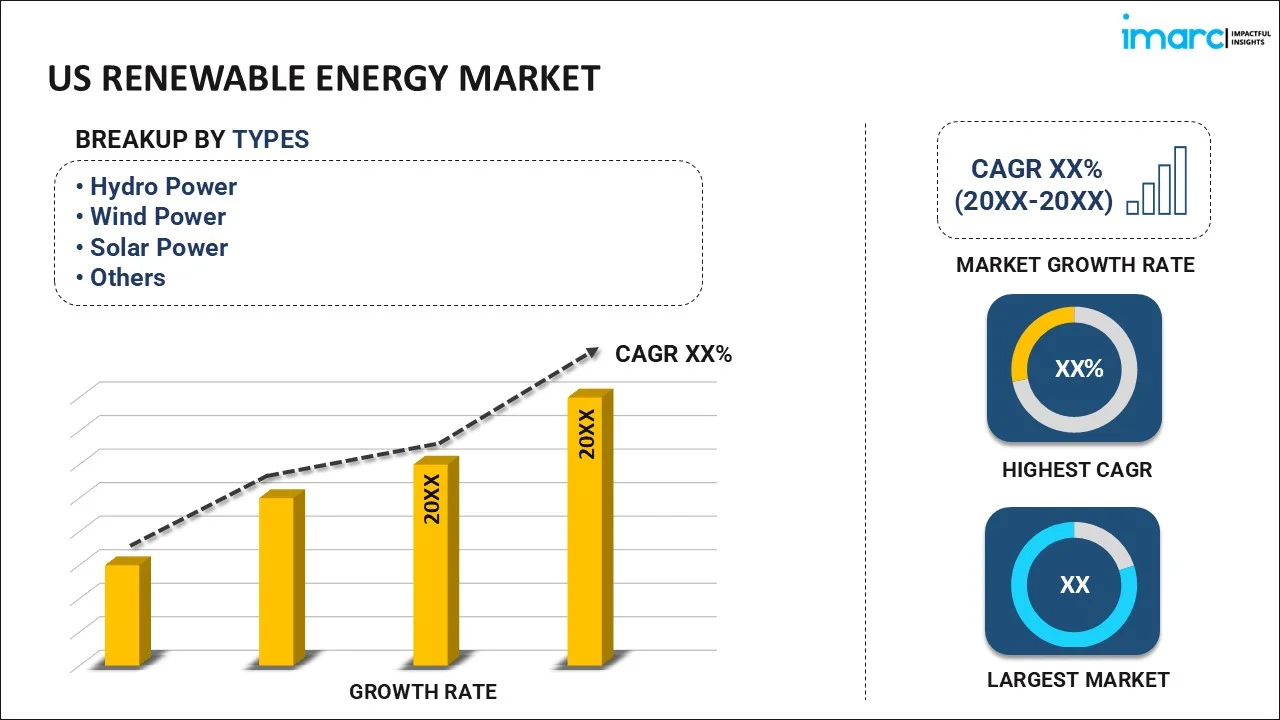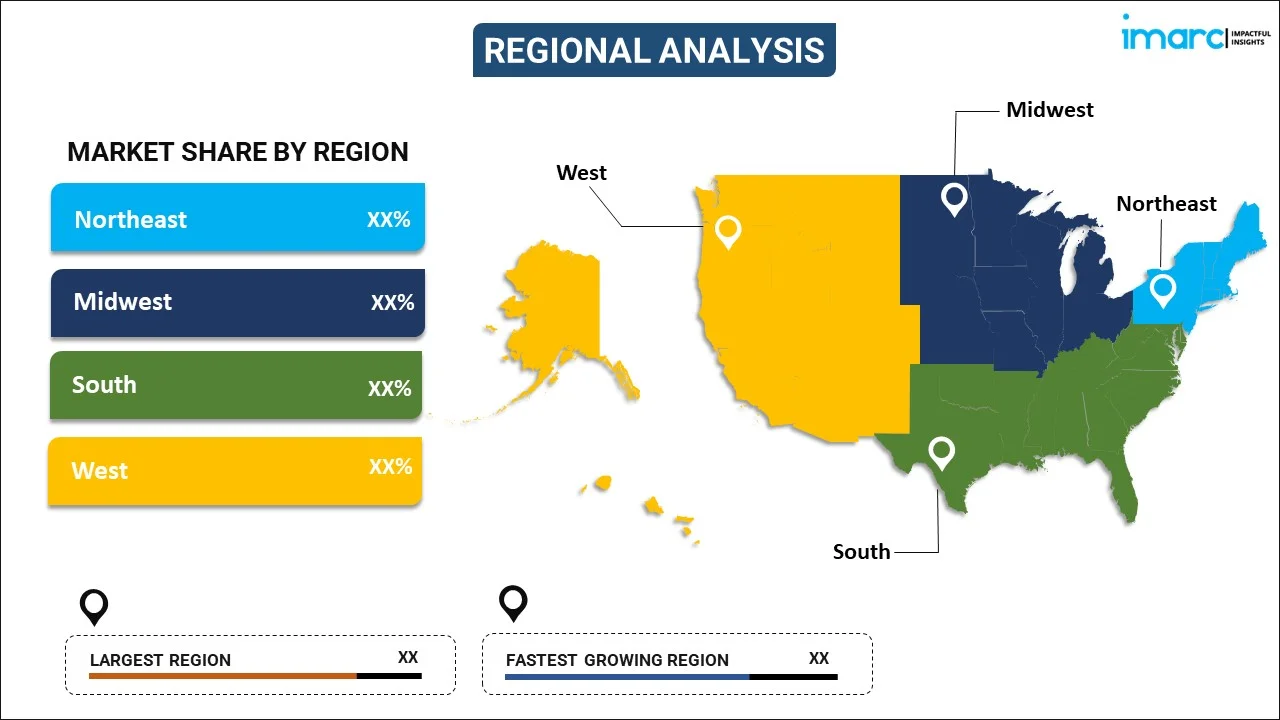
US Renewable Energy Market Report by Type (Hydro Power, Wind Power, Solar Power, Bioenergy, and Others), End User (Industrial, Residential, Commercial), and Region 2024-2032
US Renewable Energy Market Size:
US renewable energy market size is projected to exhibit a growth rate (CAGR) of 10.31% during 2024-2032. The growing concerns towards conserving resources, improving air quality, protecting biodiversity, and mitigating the adverse impact of climate change are primarily driving the market growth across the country.
|
Report Attribute
|
Key Statistics
|
|---|---|
|
Base Year
|
2023 |
|
Forecast Years
|
2024-2032
|
|
Historical Years
|
2018-2023
|
| Market Growth Rate (2024-2032) | 10.31% |
Renewable energy encompasses environmentally friendly power derived from resources that naturally replenish through ongoing natural processes. This category includes solar, wind, hydro, geothermal, biomass, tidal, and wave energy. Its versatile applications span electricity generation, transportation, heating and cooling, desalination, water treatment, irrigation, street lighting, space exploration, military operations, and research. In comparison to traditional energy sources, renewable energy stands out for its abundance, sustainability, cost-effectiveness, ease of access, and the substantial reduction of carbon footprint. Not only does it ensure long-term energy stability and reduce reliance on fossil fuels, but it also fosters resilience and supports energy diversification. The benefits extend to environmental protection, improved public health, bolstering local economies, and elevating overall quality of life.
The U.S. renewable energy market is instrumental in environmental protection and public health improvement as well as serves as a catalyst for supporting local economies and elevating overall quality of life. Additionally, as the nation commits to a cleaner and more sustainable energy future, the renewable energy market will continue to grow over the forecasted period.
US Renewable Energy Market Trends:
Growing Scope of Renewable Energy Applications
The US renewable energy market stands at the forefront of a transformative shift towards sustainable and clean energy solutions. Encompassing a diverse array of sources such as solar, wind, hydro, geothermal, biomass, tidal, and wave energy, the market plays a pivotal role in the nation's pursuit of eco-friendly alternatives. Besides this, the applications of renewable energy in the U.S. are extensive, covering electricity generation, transportation, heating and cooling, desalination, water treatment, irrigation, street lighting, space exploration, military operations, and research activities, thereby bolstering the market growth. Moreover, renowned for its abundance, sustainability, cost-effectiveness, and reduced carbon footprint, renewable energy stands in stark contrast to conventional energy sources. It ensures long-term energy stability as well as diminishes dependence on fossil fuels, fostering resilience and promoting energy diversification.
Emergence of Energy Storage Solutions
As renewable energy generated with the help of solar and wind power can be infrequent, energy storage technologies, particularly lithium-ion batteries, have become crucial for the storage of additional power generated, thereby catering to the supply-demand gap. The growing integration of energy storage systems is a significant trend shaping the market dynamics in the US. The growing adoption of battery storage also encourages the deployment of decentralized energy solutions, including smart grids and microgrids, delivering flexibility and resilience in distribution of energy. These solutions help improve the reliability on grid and enable enhanced penetration of renewables in the energy mix. This trend is enabling the country to build a more sustainable, diversified, and stable energy infrastructure.
Expansion of Offshore Wind Energy
While onshore wind energy has achieved significant progress over the years, the potential of offshore wind power is majorly untapped. The enormous coastlines in the US present an exceptional platform for harnessing consistent and robust wind speeds, offering an opportunity to expand clean energy production remarkably. Recognizing this, the US Department of Energy (DOE) has laid out a wide-ranging offshore wind energy strategy to augment the infrastructural development of offshore wind. The plan outlines the deployment of 30 gigawatts capacity of offshore wind generation by 2030, while formulating a pathway to achieve 110 gigawatts or more by 2050. This roadmap depicts the commitment to advance floating offshore wind technology, which will open up deeper waters for generating wind energy. The strategy also supports the deployment of 15 gigawatts capacity of offshore wind by 2035. This approach positions offshore wind as a mainstay in the clean energy future of the country.
US Renewable Energy Market Segmentation:
IMARC Group provides an analysis of the key trends in each segment of the market, along with forecasts at the country level for 2024-2032. Our report has categorized the market based on type and end user.
Type Insights:

- Hydro Power
- Wind Power
- Solar Power
- Bioenergy
- Others
The report has provided a detailed breakup and analysis of the market based on the type. This includes hydro power, wind power, solar power, bioenergy, and others.
End User Insights:
- Industrial
- Residential
- Commercial
A detailed breakup and analysis of the market based on the end user have also been provided in the report. This includes the industrial, residential, and commercial.
Regional Insights:

- Northeast
- Midwest
- South
- West
The report has also provided a comprehensive analysis of all the major regional markets, which include the Northeast, Midwest, South, and West.
Competitive Landscape:
The market research report has also provided a comprehensive analysis of the competitive landscape in the market. Competitive analysis such as market structure, key player positioning, top winning strategies, competitive dashboard, and company evaluation quadrant has been covered in the report. Also, detailed profiles of all major companies have been provided.
US Renewable Energy Market Report Coverage:
| Report Features | Details |
|---|---|
| Base Year of the Analysis | 2023 |
| Historical Period | 2018-2023 |
| Forecast Period | 2024-2032 |
| Units | Million USD |
| Scope of the Report | Exploration of Historical and Forecast Trends, Industry Catalysts and Challenges, Segment-Wise Historical and Predictive Market Assessment:
|
| Types Covered | Hydro Power, Wind Power, Solar Power, Bioenergy, Others |
| End Users Covered | Industrial, Residential, Commercial |
| Regions Covered | Northeast, Midwest, South, West |
| Customization Scope | 10% Free Customization |
| Post-Sale Analyst Support | 10-12 Weeks |
| Delivery Format | PDF and Excel through Email (We can also provide the editable version of the report in PPT/Word format on special request) |
Key Questions Answered in This Report:
- How has the US renewable energy market performed so far and how will it perform in the coming years?
- What has been the impact of COVID-19 on the US renewable energy market?
- What is the breakup of the US renewable energy market on the basis of type?
- What is the breakup of the US renewable energy market on the basis of end user?
- What are the various stages in the value chain of the US renewable energy market?
- What are the key driving factors and challenges in the US renewable energy market?
- What is the structure of the US renewable energy market and who are the key players?
- What is the degree of competition in the US renewable energy market?
Key Benefits for Stakeholders:
- IMARC’s industry report offers a comprehensive quantitative analysis of various market segments, historical and current market trends, market forecasts, and dynamics of the US renewable energy market from 2018-2032.
- The research report provides the latest information on the market drivers, challenges, and opportunities in the US renewable energy market.
- Porter's five forces analysis assist stakeholders in assessing the impact of new entrants, competitive rivalry, supplier power, buyer power, and the threat of substitution. It helps stakeholders to analyze the level of competition within the US renewable energy industry and its attractiveness.
- A competitive landscape allows stakeholders to understand their competitive environment and provides an insight into the current positions of key players in the market.
Need more help?
- Speak to our experienced analysts for insights on the current market scenarios.
- Include additional segments and countries to customize the report as per your requirement.
- Gain an unparalleled competitive advantage in your domain by understanding how to utilize the report and positively impacting your operations and revenue.
- For further assistance, please connect with our analysts.
 Inquire Before Buying
Inquire Before Buying
 Speak to an Analyst
Speak to an Analyst
 Request Brochure
Request Brochure
 Request Customization
Request Customization




.webp)




.webp)












